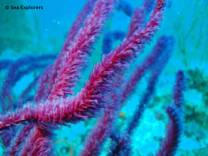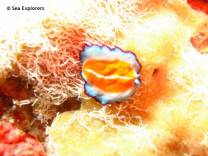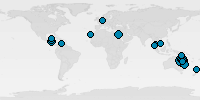
The Maldives are a collection of pretty atolls with hundreds of pristine islands, coral reefs and scuba diving sites.
Take a look at all the pictures!
Recent diving activity from our members
South Male Atoll is a great drift diving atoll with sharks, coral reef fish and plenty of soft corals.
- Gulhi, Dhigufinolhu
- Maldives
Attracted by one cave after another we are gliding with the current from one washout to the next. The Vellasaru Caves ar...
- Cathedral: As the name implies we find a huge overhang on the...
- Maldive Victory Wreck: A trip out to the 60 meters long cargo wreck of th...
Kahambu Corner is named after the turtles that often feed on the shallow parts of this reef.
- Kudarah Thila
- Broken Rock Thila
Maagiri Caves is one of the few cave dives around Male with many glass fish and resting nurse sharks.
- Lion's Head
- Cathedral
On the north side of Vaadhoo Resort about 50 minutes from Male' you can find the Vaadhoo Caves or Wadu Caves. Here the r...
- Old Shark Point: Old Shark Point is located west of Male, only 30 m...
The British Loyalty wreck is one of the most famous wrecks in the Maldives and certainly while diving Addu Atol or Seenu.
- Sepp's Place
- Fusilier Reef
Scuba diving at the Maldives is simply perfect. Lots of extremely pretty atolls located southwest of India in the Indian Ocean, offering all sorts of dive sites. They form a straight 800km long north-southern line along the equator separated in an eastern and western chain. The best known atolls are North and South Male Atoll, administratively called Kaafu, also situating the capital Male and its international airport where most visitors arrive. Popular atolls nearby are Felidhoo Atoll (Vaavu), Mulaku Atoll (Meemu), South and North Nilandhoo Atoll (Dhaalu and Faafu), Ari Atoll (Alifu) and Faadhippolhu Atoll (Lhaviyani). Other popular destinations are Addu Atoll (Seenu), North Maalhosmadulu Atoll (Raa) and South Maalhosmadulu Atoll (Baa). Less visited atolls in the south include Fuamulaku Atoll (Gnaviyani), Huvadhoo Atoll (Faaf Alif and Gaaf Dhaal) and Hadhdhunmathee Atoll (Laamu). In the upper north you can find the atolls Ihavanhippolhu Atoll, Thiladhunmathee Atoll and Miladhunmadulu Atoll which form actually one long reef (Haa Alifu, Haa Dhaal, Shaviyani and Noonu). Each atoll consists out of large reefs and numerous faros reefs, each having its own reef rims, channels, secluded islands and internal lagoons. Many of these small islands are bought by luxury clubs and transformed into resort islands; hence many people know an atoll by the name of the resort or club that stands there. Maldives resorts are famous for their luxury beach bungalows. Island hopping is a popular activity and will allow you to see some of Maldivian daily life.
Diving on most atolls around the Maldives is simply perfect. However, a phenomenon called 'washing machine effect' is present at most atolls. The already strong currents can be interrupted by local crosscurrents and whirlpools that can disorient an inexperienced diver or take you away from the reef. Try to avoid these, but if taken by them, don't stress since they are not dangerous. Simply return to the reef or surface and swim back to the boat. You often use a negative buoyancy entry to get past the heaviest surface currents to regroup in mid-water and start your dive. As with most atolls, expect high speed drift diving on the outside of the outer reef (and inside kandus) and pretty relaxed coral diving on the inner side in the lagoon. There is also often a cold thermocline once you reach deep waters so dress appropriately.
Besides scuba diving and water activities, all you can do here is relax on its white sandy beaches, enjoy its fabulous dining and secluded but luxury accommodations. These Robinson Crusoe islands are dazzling tropical beauties, often used for honeymoon trips. The Maldives have a brilliant climate, 30 degrees year-round with water temperatures of 28 degrees. The mild northeast monsoon runs from December to April while the rougher southwest monsoons picks up between May and November. The great tsunami of December 2004 triggered huge waves that flooded large parts of Male and many of the other low-lying coral islands. Transportation throughout the Maldives is mostly done by live aboard, cruises, seaplanes, safari boats, fast speedboats and small motorized vessels called dhoni. Liveaboard diving is one of the best ways to explore the Maldives in its full glory, visiting many secluded islands and pristine bays, diving on top of some of the best coral reefs and dive sites in the world. Well known marine life include many types of sharks, manta rays, whale sharks, eagle rays, barracuda and tuna.












